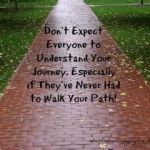 One afternoon I took a walk at a beautiful lake surrounded by woods with a main paved path and smaller trails through the woods. I decided to take a wooded trail, but as I moved further from the main path, the trail became less clear. I was afraid of getting lost in the woods. When I looked around me, I realized that some of the trees had blue paint marks on them.
One afternoon I took a walk at a beautiful lake surrounded by woods with a main paved path and smaller trails through the woods. I decided to take a wooded trail, but as I moved further from the main path, the trail became less clear. I was afraid of getting lost in the woods. When I looked around me, I realized that some of the trees had blue paint marks on them.
Every few feet stood a tree with another blue mark. By following the marks, I was able to follow the trail through the woods to the main path as it circled around the lake. When I got to the main path again, I wasn’t sure which direction to walk to get back to my car. Luckily, another walker was passing by who pointed me in the right direction. If I had gotten lost, the walk could have been a disaster, but because I had signs to guide me and people to help me when I needed help, it was a wonderful experience. But, it wasn’t only the signs and the fellow walker that made the difference. I used my skills and I wasn’t afraid to ask the fellow traveler for help. I advocated for myself, and I felt confident and positive after my walk.
Navigating your way towards motherhood is a lot like that walk. You are entering unfamiliar territory, and you will have to find your way through. Whether you pursue motherhood the “old fashioned” way, or through assisted reproductive technology, adoption, surrogacy, or some other method, the steps to making informed decisions and to advocating for your needs throughout the process are remarkably similar. Here are some tips to guide you on your journey. First, learn the basics. Each route to motherhood has numerous pathways with choices to be made along the way. Do some research to get the lay of the land and learn all the initial options that are available. Looking for controversies and alternatives to the mainstream way of doing things can lead to important discoveries. Exploring the negative side of things can give you a more complete view of the choices that you are likely to confront down the road.
Next, find your community. Whichever trail you choose, there are people who are going, or have already gone, down the same path. Whether you find the group in your local community or online, you are likely to find people who know the ins and outs, tips, and tricks to navigate the system. These fellow travelers will know the reputations of caregivers, facilities, agencies, and businesses that you might encounter, and can provide you with emotional support along your journey. Sometimes the best people to help you navigate the system are professionals who charge a fee for their services. Like a trail guide can lead you safely through a mountain pass, hiring a professional to help you can be a worthwhile investment to move you through the process.
Also, know thyself. Do an assessment of your needs, wants, and values. Having clarity on these helps with decision-making because you can use them as measures and guides as you encounter choices. Most medical practices, agencies, and businesses rely on standardized activities because those allow them to function more smoothly, but individualization gets lost in the process. You will have to know what your needs are to effectively advocate for them in order to receive individualized care.
Demand to know the facts. Evidence-based practices are documented by research, and if documentation doesn’t exist for something someone is telling you to do, you should know that too. Ask about all the options available, the complete list of their risks and benefits, and their probabilities. And, don’t just take someone’s word for it, no matter how much of an authority they are. Experts should back up their statements with facts that you should be able to have access to. Do your own research to make sure you have a thorough-enough understanding to make informed decisions. Problems arise when you give up your decision-making power to others by figuring they know more than you and are therefore more qualified to make the decisions. Usually, conflicts occur not because others take advantage of the situation, but because their needs, wants, and values may be different than yours. They may make different choices than you would make for yourself.
Be a vocal, active participant. Voice your needs, wants, concerns, thoughts, and opinions. Recognize the learning process you are undergoing and talk about the changes you are going through. This allows for people to adjust to your changing needs so they can do a better job working with you. Giving both negative and positive feedback about your experiences to the people and agencies with which you are working makes improvement possible. Most people want to be helpful and do a good job, so they appreciate constructive feedback that helps them do better. Then, when you have completed the journey, share your knowledge with others who are traveling after you. Be the helper to someone else.
Getting to motherhood is a life journey that demands both thought and action, no matter which route you take to get to the destination. Advocating for yourself and having people and signs to guide you can make the difference between getting there feeling travel-weary and beaten by the elements, or feeling triumphant, powerful, and ready to parent. Both paths are in front of you. Which would you prefer?
Michal Klau-Stevens is The Birth Lady. She is the creator of the Mastering Maternity™ system, a program that helps childbearing women confidently approach pregnancy, birth, breastfeeding, early parenting, and navigating the maternity healthcare system. She is a maternity consultant, pregnancy coach, consumer expert on maternity care issues, Past President of BirthNetwork National, Lamaze Certified Childbirth Educator, and mother. Her website is TheBirthLady.Info. Find her on facebook at The Birth Lady page!

